National Register of Historic Places listings in Ramsey County, Minnesota

This is a complete list of National Register of Historic Places listings in Ramsey County, Minnesota. It is intended to be a complete list of the properties and districts on the National Register of Historic Places in Ramsey County, Minnesota, United States. The locations of National Register properties and districts for which the latitude and longitude coordinates are included below, may be seen in an online map.
There are 111 properties in the county listed on the National Register of Historic Places including three National Historic Landmarks. A supplementary list includes five additional sites that were formerly listed on the National Register. Another supplementary list includes eight additional sites that were nominated but never officially listed, and which may mistakenly appear in secondary sources.
- This National Park Service list is complete through NPS recent listings posted December 16, 2016.[1]
History

Ramsey County is a county located in the southeastern part of the U.S. state of Minnesota, bounded in some places by the Mississippi River, by Hennepin County, Anoka County, Washington County, and Dakota County. All of the county seat, Saint Paul, is in the county, including Saint Paul's "West Side" neighborhood, which is south of the Mississippi River.
The county's historic places include houses, places of worship, commerce, and education, and community centers and infrastructure. Several districts encompass several structures of related historic significance. Some of the oldest structures in the state are in Ramsey County, representing the earliest of non-indigenous residents in the state. As the northernmost natural port on the Upper Mississippi River, Saint Paul grew, handling both river and rail freight and passenger traffic. Even as Minneapolis (in Hennepin County) eventually surpassed Saint Paul in the volume of commerce, Saint Paul remained relevant as the state capital and associated government services and employment kept the county growing. Several of the sites are specifically related to the various first-generation immigrant populations that made Ramsey County their new home in the United States, especially Germans, Czechs, Scandinavians, and Austro-Hungarians, which together comprised the majority of residents in the first century of the county's history.
Current listings
| [2] | Name on the Register[3] | Image | Date listed[4] | Location | City or town | Description |
|---|---|---|---|---|---|---|
| 1 | 3M Administration Building | |
(#14001212) |
777 Forest Street 44°57′53″N 93°03′46″W / 44.964632°N 93.062729°W |
Saint Paul | Moderne headquarters of 3M from 1940 to 1962, reflecting the corporation's success through research, product development, and diversification.[5] |
| 2 | Arlington Hills Library |  |
(#84001660) |
1105 Greenbrier Street 44°58′28″N 93°04′16″W / 44.974444°N 93.071111°W |
Saint Paul | One of three Beaux-Arts Carnegie libraries built in Saint Paul 1916–17, significant for their role in education and as city architect Charles A. Hausler's first public buildings. |
| 3 | John M. Armstrong House | 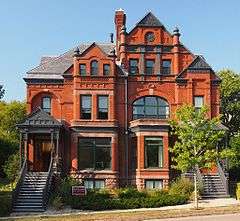 |
(#83000925) |
225 Eagle Parkway 44°56′28″N 93°06′03″W / 44.941111°N 93.100833°W |
Saint Paul | Sophisticated early work of architect Edward Bassford—built in 1886—and downtown Saint Paul's only surviving semi-detached house.[6] |
| 4 | Assumption School |  |
(#75001005) |
68 Exchange Street 44°56′51″N 93°06′00″W / 44.9475°N 93.1°W |
Saint Paul | Early parochial school active 1864–1888 in educating children of the Church of the Assumption's largely German immigrant congregation. Also noted for its limestone Italian Villa style.[7] |
| 5 | Dr. Ward Beebe House | 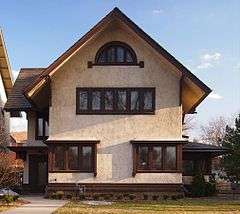 |
(#77000762) |
2022 Summit Avenue 44°56′28″N 93°11′09″W / 44.941111°N 93.185833°W |
Saint Paul | 1912 house representative of Purcell & Elmslie's local Prairie School residences.[8] Also a contributing property to the West Summit Avenue Historic District.[9] |
| 6 | Blair Flats | 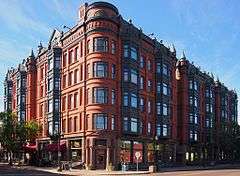 |
(#75001006) |
165 Western Avenue 44°56′47″N 93°06′58″W / 44.946389°N 93.116111°W |
Saint Paul | Highly fashionable 1887 Victorian apartment building commissioned by entrepreneur Frank P. Blair.[10] Also a contributing property to the Historic Hill District.[11] |
| 7 | Bridges No. L-5853 and 92247 |  |
(#89001842) |
Lexington Avenue in Como Park 44°58′42″N 93°08′47″W / 44.978333°N 93.146389°W |
Saint Paul | Minnesota's second-oldest reinforced-concrete arch bridges, designed in 1904 by William S. Hewett using Josef Melan's revolutionary reinforcing system.[12] |
| 8 | Markell and Edward Brooks, Sr. House |  |
(#00000689) |
176 Mississippi River Boulevard North 44°56′47″N 93°11′54″W / 44.946389°N 93.198333°W |
Saint Paul | Exemplary 1920s Colonial Revival estate designed and expanded by Clarence H. Johnston, Sr.'s firm. Now Eastcliff, the official residence of the University of Minnesota system president.[13] |
| 9 | Benjamin Brunson House |  |
(#75001007) |
485 Kenny Rd. 44°57′27″N 93°04′48″W / 44.9575°N 93.08°W |
Saint Paul | 1855 Federal house of pioneering civic leader Benjamin Brunson (1823–1898), surveyor and co-founder of Saint Paul.[14] |
| 10 | Casiville Bullard House | 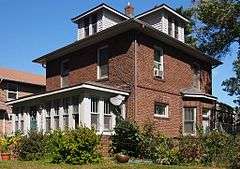 |
(#96001559) |
1282 Folsom Street 44°58′48″N 93°07′57″W / 44.979917°N 93.132417°W |
Saint Paul | 1909 house built for himself by prolific stonemason and bricklayer Casiville Bullard (1873–1959), one of Saint Paul's few skilled African Americans working in the building trade in the early 20th century.[15] |
| 11 | Burbank-Livingston-Griggs House | 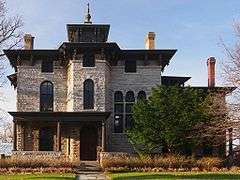 |
(#70000307) |
432 Summit Avenue 44°56′27″N 93°07′06″W / 44.940863°N 93.118358°W |
Saint Paul | 1863 limestone house considered one of Minnesota's most elaborate examples of mid-19th-century Italianate architecture.[16] Also a contributing property to the Historic Hill District.[11] |
| 12 | Pierce and Walter Butler House | 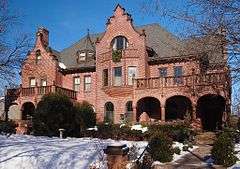 |
(#82004625) |
1345–1347 Summit Avenue 44°56′31″N 93°09′26″W / 44.941942°N 93.157204°W |
Saint Paul | Distinctive 1900 double house of brothers Pierce Butler (a U.S. Supreme Court justice 1923–1939) and Walter Butler (a leading Midwestern contractor).[17] Also a contributing property to the West Summit Avenue Historic District.[9] |
| 13 | C.S.P.S. Hall | 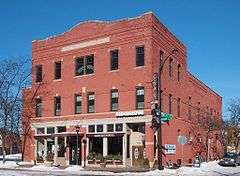 |
(#77000763) |
381–383 Michigan Street 44°56′07″N 93°06′58″W / 44.935278°N 93.116111°W |
Saint Paul | 1887 Czech-Slovak Protective Society meeting hall serving Saint Paul's small but active Czech American community.[18] |
| 14 | Central Presbyterian Church |  |
(#83000926) |
500 Cedar Street 44°56′59″N 93°05′46″W / 44.949722°N 93.096111°W |
Saint Paul | One of Saint Paul's largest and finest Richardsonian Romanesque churches, built 1888–90, and one of its few designs by Minneapolis-based church architect Warren H. Hayes.[19] |
| 15 | Church of St. Agnes-Catholic | 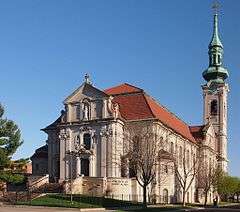 |
(#80002125) |
548 Lafond Avenue 44°57′35″N 93°07′24″W / 44.959722°N 93.123333°W |
Saint Paul | Landmark Baroque Revival church built 1901–12 for an Austro-Hungarian immigrant congregation.[20] |
| 16 | Church of St. Bernard-Catholic | 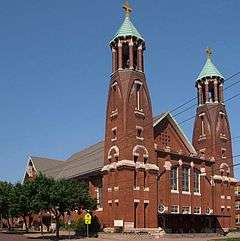 |
(#83000927) |
197 Geranium Avenue West 44°58′33″N 93°06′28″W / 44.975867°N 93.107766°W |
Saint Paul | Church built 1905–14 noted for its innovative Prairie School/Art Nouveau design and early reinforced-concrete construction, and as a masterpiece of architect John Jager (1871–1959).[21] |
| 17 | Church of St. Casimir-Catholic | 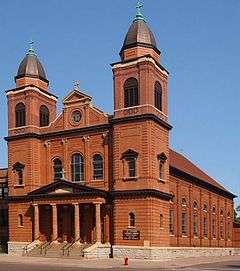 |
(#83000939) |
937 Jessamine Avenue East 44°58′30″N 93°03′40″W / 44.975°N 93.061111°W |
Saint Paul | 1904 Beaux-Arts church built for a Polish immigrant congregation.[22] |
| 18 | Church of the Assumption-Catholic | 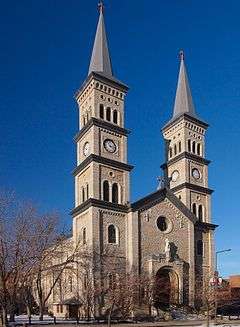 |
(#75001008) |
51 9th Street West 44°56′51″N 93°05′57″W / 44.9475°N 93.099167°W |
Saint Paul | Romanesque Revival church based on the Ludwigskirche in Munich, built 1870–74 for a German immigrant congregation.[23] |
| 19 | Cyrus B. Cobb House |  |
(#83000928) |
2199 1st Street 45°04′57″N 93°00′28″W / 45.082565°N 93.007877°W |
White Bear Lake | 1885 Queen Anne residence, one of White Bear Lake's oldest intact brick and Victorian-era houses.[24] |
| 20 | Colorado Street Bridge | 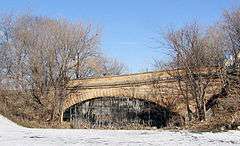 |
(#90000977) |
East side of South Wabasha Street near Terrace Park 44°56′05″N 93°05′03″W / 44.934722°N 93.084167°W |
Saint Paul | Unusual 1888 skew arch bridge, at 70 feet (21 m) also the longest masonry arch bridge built on a Minnesota highway. Converted to pedestrian use in the 1970s.[25] |
| 21 | Commerce Building | 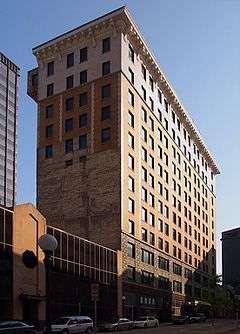 |
(#07000645) |
8 Fourth Street East 44°56′42″N 93°05′36″W / 44.944873°N 93.093296°W |
Saint Paul | 1912 office building serving as headquarters for two commerce associations 1912–21, symbolic of the business networking organizations that influenced Saint Paul's late-19th/early-20th-century economic and civic growth.[26] |
| 22 | Como Park Conservatory |  |
(#74001033) |
Como Park 44°58′53″N 93°09′03″W / 44.981389°N 93.150833°W |
Saint Paul | City botanical conservatory of glass and iron/steel trusses, built 1914–15.[27] |
| 23 | William and Catherine Davern Farm House | 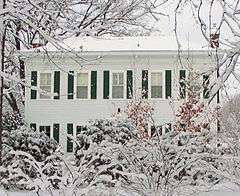 |
(#83003765) |
1173 Davern Street South 44°54′22″N 93°10′22″W / 44.90618°N 93.172721°W |
Saint Paul | Rare surviving Italianate farmhouse of one of Saint Paul's earliest farming families, built c. 1862.[28] |
| 24 | Derham Hall and Our Lady of Victory Chapel, College of Saint Catherine |  |
(#85003423) |
2004 Randolph Avenue 44°55′32″N 93°11′04″W / 44.925556°N 93.184444°W |
Saint Paul | 1903 campus hall and 1923 Romanesque Revival chapel, the oldest structures at St. Catherine University.[29] |
| 25 | Euclid View Flats | 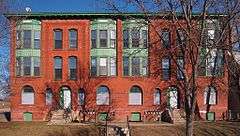 |
(#13001170) |
234–238 Bates Avenue 44°57′14″N 93°03′59″W / 44.953834°N 93.066306°W |
Saint Paul | Early example of an apartment building designed to appeal to the middle class, constructed 1894–95 in a transitional Queen Anne/Romanesque Revival style.[30] |
| 26 | Finch, Vanslyck, and McConville Dry Goods Company Building |  |
(#82004626) |
366 Wacouta Street 44°56′59″N 93°05′13″W / 44.949722°N 93.086944°W |
Saint Paul | Large warehouse built in 1911 (expanded 1923), representative of Saint Paul's major wholesaling industry.[31] Also a contributing property to the Lowertown Historic District.[32] |
| 27 | First Baptist Church of Saint Paul |  |
(#83000929) |
499 Wacouta Street 44°57′09″N 93°05′25″W / 44.9525°N 93.090139°W |
Saint Paul | Costly 1874 Gothic Revival church designed by William W. Boyington in the now largely-vanished Lowertown neighborhood for Minnesota's oldest Baptist congregation.[33] |
| 28 | First National Bank of White Bear | 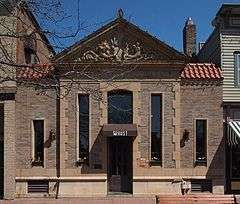 |
(#83000930) |
4744 Washington Avenue 45°05′05″N 93°00′32″W / 45.084741°N 93.0088°W |
White Bear Lake | 1921 Neoclassical bank with an atypical Spanish tile eave; White Bear Lake's most sophisticated early commercial building and a key financial institution in its growth from a resort town to an established city.[34] |
| 29 | F. Scott Fitzgerald House | 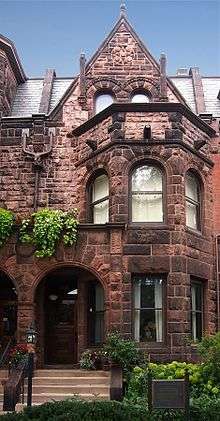 |
(#71000440) |
599 Summit Avenue 44°56′30″N 93°07′31″W / 44.941528°N 93.125139°W |
Saint Paul | Rowhouse where author F. Scott Fitzgerald lived with his parents 1919–20 while writing This Side of Paradise, his first novel to be published.[35] Also a contributing property to the Historic Hill District.[11] |
| 30 | Fitzpatrick Building | 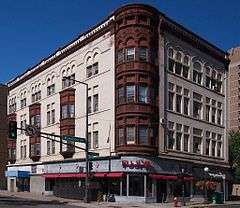 |
(#90001113) |
465–467 Wabasha Street North 44°56′53″N 93°05′50″W / 44.948194°N 93.097222°W |
Saint Paul | Well-preserved 1890 example of the Queen Anne commercial buildings of downtown Saint Paul's 1880s–1890s boom.[36] |
| 31 | Foss House | 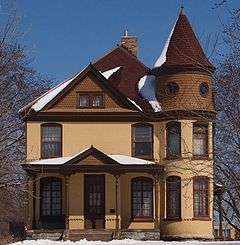 |
(#83000931) |
321 Silver Lake Rd. SW 45°02′40″N 93°13′02″W / 45.044498°N 93.217359°W |
New Brighton | Large c. 1896 Victorian house of an early family that settled the then-rural outskirts of New Brighton.[37] |
| 32 | Germania Bank Building | 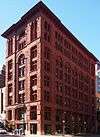 |
(#77000764) |
6 5th Street West 44°56′44″N 93°05′41″W / 44.945491°N 93.094593°W |
Saint Paul | 1889 Richardsonian Romanesque office building designed by J. Walter Stevens and Harvey Ellis; Saint Paul's only surviving brownstone skyscraper.[38] |
| 33 | Heman Gibbs Farmstead | |
(#75001009) |
2097 Larpenteur Avenue 44°59′32″N 93°11′18″W / 44.992222°N 93.188333°W |
Falcon Heights | Rare surviving farm in the Minneapolis–Saint Paul metro, established in 1849, featuring a farmhouse dating to 1854 and a 1910 barn. Now part of the Gibbs Museum of Pioneer and Dakotah Life.[39] |
| 34 | Giesen-Hauser House | 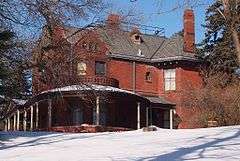 |
(#83000932) |
827 Mound Street 44°57′03″N 93°03′43″W / 44.950833°N 93.061944°W |
Saint Paul | 1891 Queen Anne house, only intact surviving work of local architect Albert Zschocke, owned successively by Peter Joseph Giesen and Eric V. Hauser, prosperous businessmen and civic leaders.[40] |
| 36 | Hamline Methodist Episcopal Church |  |
(#11000950) |
1514 Englewood Ave. 44°57′49″N 93°09′53″W / 44.963683°N 93.164767°W |
Saint Paul | 1928 Gothic Revival church exhibiting high craftsmanship by local architects Slifer & Abrahamson and stained glass artist Andreas R. Larsen.[41] |
| 37 | Hamm Building |  |
(#97000499) |
408 Saint Peter Street 44°56′47″N 93°05′48″W / 44.946455°N 93.096664°W |
Saint Paul | Commercial building built 1915–20, significant for its atypical cantilevered steel construction and grand terracotta exterior.[42] |
| 38 | Harriet Island Pavilion | 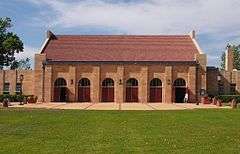 |
(#92000821) |
75 Water Street 44°56′15″N 93°05′50″W / 44.9375°N 93.097222°W |
Saint Paul | Prominent 1941 Moderne park shelter designed by Clarence W. Wigington, believed to be the nation's first African American municipal architect.[43] Renamed the Wigington Pavilion in 2000 in his honor.[44] |
| 39 | Highland Park Tower |  |
(#86001670) |
1570 Highland Pkwy. 44°55′03″N 93°10′00″W / 44.917611°N 93.166667°W |
Saint Paul | Octagonal 1928 water tower noted for its architectural significance, iconic status to the neighborhood, and association with pioneering black architect Clarence W. Wigington.[45] |
| 40 | James J. Hill House |  |
(#66000405) |
240 Summit Avenue 44°56′42″N 93°06′32″W / 44.945°N 93.108889°W |
Saint Paul | 1889 mansion of railroad magnate and financier James J. Hill (1838–1916).[46] Also a contributing property to the Historic Hill District.[11] |
| 41 | James J. Hill's North Oaks Farm, Dairy Building | |
(#97000441) |
Red Barn Road and Hill Farm Circle 45°05′33″N 93°06′30″W / 45.0925°N 93.108333°W |
North Oaks | State-of-the-art 1884 demonstration creamery representing James J. Hill's promotion of diversified farming in the American Northwest.[47] |
| 42 | James J. Hill's North Oaks Farm, Dairy Building, Granary Root Cellar and Auxiliary Buildings, Boundary Increase | 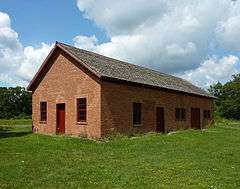 |
(#98000311) |
Red Barn Rd., jct. of Hill Farm Circle and Evergreen Rd. 45°05′33″N 93°06′30″W / 45.0925°N 93.108333°W |
North Oaks | Remnants of James J. Hill's experimental crop and livestock farm, established 1884–90 to promote diversified farming along his Great Northern Railway.[48] Now a non-profit historic attraction.[49] |
| 43 | Ann Charlotte and Jacob Hinkel House |  |
(#78001558) |
531 Brainerd Avenue 44°58′49″N 93°04′42″W / 44.980297°N 93.078287°W |
Saint Paul | 1872 Italian Villa style house, rare example of a wealthy country estate that has survived Saint Paul's urban expansion.[50] |
| 44 | Historic Hill District |  |
(#76001067) |
Irregular pattern from Pleasant and Grand Avenues to Holly and Marshall Avenues, from Lexington Parkway to 4th and Pleasant Streets 44°56′37″N 93°07′07″W / 44.943611°N 93.118611°W |
Saint Paul | Minnesota's largest concentration of late-19th- and early-20th-century architectural styles built for the upper and upper-middle class, with 980 contributing properties on 75 blocks.[11][51] |
| 45 | E. H. Hobe House-Solheim | 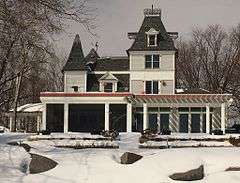 |
(#83000933) |
5590 Bald Eagle Boulevard West 45°06′37″N 93°01′35″W / 45.110248°N 93.026291°W |
White Bear Lake | 1897 Victorian mansion of Norwegian American diplomat Engelbrecht H. Hobe (1860–1940), longtime consul for the United Kingdoms of Sweden and Norway.[52] |
| 46 | Holman Field Administration Building | |
(#91001004) |
644 Bayfield Street 44°56′31″N 93°03′53″W / 44.941944°N 93.064722°W |
Saint Paul | Sophisticated 1939 Moderne airport terminal designed by pioneering black architect Clarence W. Wigington and built in cooperation with the Works Progress Administration.[53] |
| 47 | Indian Mounds Park Mound Group | 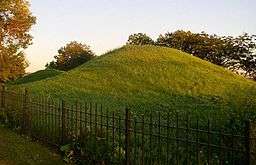 |
(#14000140) |
1075 Mounds Blvd. 44°56′45″N 93°03′24″W / 44.945833°N 93.056667°W |
Saint Paul | Prominent blufftop burial mound site in use c. 1000 BCE to 1837 by the northernmost Hopewell tradition people up to early contact Dakota people. Also noted as a focus of the earliest archaeological efforts in Minnesota 1856–1900.[54] |
| 48 | Intercity Bridge |  |
(#89001838) |
Ford Pkwy. over Mississippi River 44°55′04″N 93°12′05″W / 44.917861°N 93.201361°W |
Saint Paul | Monumental 1927 reinforced-concrete continuous-rib arch bridge designed by Martin Sigvart Grytbak. Extends into Hennepin County and better known as the Ford Bridge.[55] |
| 49 | Horace Hills Irvine House |  |
(#74001034) |
1006 Summit Avenue 44°56′28″N 93°08′33″W / 44.941111°N 93.1425°W |
Saint Paul | 1911 Tudor Revival mansion designed by William Channing Whitney, donated to the state in 1965 to become the official Minnesota Governor's Residence.[56] Also a contributing property to the Historic Hill District.[11] |
| 50 | Irvine Park Historic District | 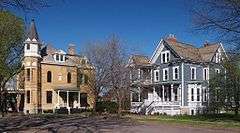 |
(#73000993) |
Roughly bounded by Irvine Park, West 7th, Walnut, and Sherman 44°56′27″N 93°06′10″W / 44.940879°N 93.102686°W |
Saint Paul | Residential district preserving the fine homes of many of Minnesota's early leading citizens, with 20 contributing properties built 1849–1889.[57][58] |
| 51 | Frank B. Kellogg House | 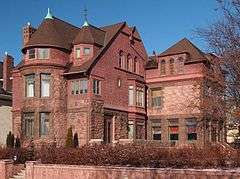 |
(#74001035) |
633 Fairmount Avenue 44°56′14″N 93°07′36″W / 44.937222°N 93.126667°W |
Saint Paul | 1889 Queen Anne/Richardsonian Romanesque house of Frank B. Kellogg (1856–1937), who helped transform U.S. foreign policy as Secretary of State 1925–1929.[59] |
| 52 | Krank Manufacturing Company |  |
(#83000934) |
1855 University Avenue West 44°57′25″N 93°10′45″W / 44.956944°N 93.179167°W |
Saint Paul | Exceptional 1926 industrial building designed by Toltz, King & Day with terracotta ornamentation. Also associated with the development of Saint Paul's Midway neighborhood and Minnesota's cosmetics industry.[60] |
| 53 | Lauer Flats | 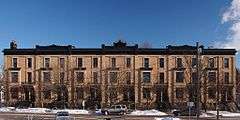 |
(#75001010) |
226 Western Avenue South 44°56′04″N 93°06′56″W / 44.934444°N 93.115639°W |
Saint Paul | Elegantly restrained 1887 Italianate apartment building featuring precise and largely unornamented stonework.[61] |
| 54 | Olaf Lee House | 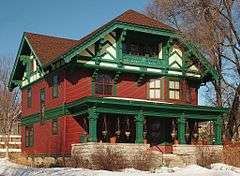 |
(#84001670) |
955 Jessie Street North 44°58′12″N 93°04′40″W / 44.969971°N 93.077709°W |
Saint Paul | Unusual 1905 house designed by Clarence H. Johnston, Sr. in an eclectic Swiss chalet/American Craftsman style.[62] |
| 55 | Lock and Dam No. 2 | |
(#03000522) |
Mississippi River north of Lake Street/Marshall Avenue 44°57′14″N 93°12′28″W / 44.953889°N 93.207778°W |
Saint Paul | Remains of the first lock and dam complex on the Upper Mississippi River, in use 1907–1912. Better known as the Meeker Island Lock and Dam, it's primarily listed in Hennepin County but extends into Ramsey County.[63] |
| 56 | Lowertown Historic District |  |
(#83000935) |
Roughly bounded by Kellogg Boulevard, Broadway, 7th and Jackson Streets 44°56′58″N 93°05′16″W / 44.949444°N 93.087778°W |
Saint Paul | 16-block warehouse and wholesaling district with 37 contributing properties built 1890s–1910, significant for its river and rail connections, economic impact, architecture, and urban planning.[64] |
| 57 | David Luckert House |  |
(#75001011) |
480 Iglehart Street 44°56′58″N 93°07′13″W / 44.949306°N 93.120278°W |
Saint Paul | Well-preserved limestone house built in the late 1850s, one of the oldest houses in Saint Paul outside of the city's historic core.[65] |
| 58 | Manhattan Building | 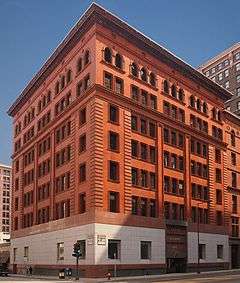 |
(#88001128) |
360 Robert Street North 44°56′51″N 93°05′26″W / 44.9474°N 93.090565°W |
Saint Paul | 1890 Renaissance Revival bank and office building dating to Saint Paul's 1880s–1890s boom, designed and then tenanted by Clarence H. Johnston, Sr. while serving as State Architect 1891–1936.[66] |
| 59 | Andrew R. McGill House | 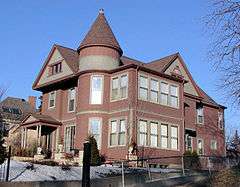 |
(#74001037) |
2203 Scudder Avenue 44°58′37″N 93°11′31″W / 44.976944°N 93.191944°W |
Saint Paul | 1888 Queen Anne mansion of politician Andrew Ryan McGill, governor of Minnesota 1887–1889 and later a state senator and Saint Paul postmaster.[67] |
| 60 | Mendota Road Bridge | 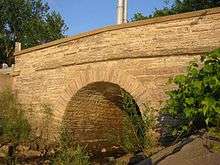 |
(#89001825) |
Water Street over Pickerel Lake Outlet 44°55′31″N 93°06′41″W / 44.925278°N 93.111389°W |
Saint Paul | 1894 masonry arch bridge, a rare Saint Paul example of a small, 19th-century, city bridge that hasn't been replaced or altered.[68] |
| 61 | Merchants National Bank | 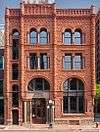 |
(#74001036) |
366–368 Jackson Street 44°56′54″N 93°05′22″W / 44.948274°N 93.08946°W |
Saint Paul | 1892 remnant of the sandstone Richardsonian Romanesque buildings of Saint Paul's late-19th-century growth, designed by Edward Bassford to house an influential bank and the law offices of several prominent Minnesotans.[69] Now known as the Brooks Building. |
| 62 | Mickey's Diner | 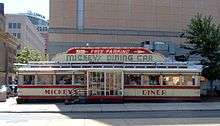 |
(#83000936) |
36 7th Street West 44°56′51″N 93°05′53″W / 44.947446°N 93.098135°W |
Saint Paul | Minnesota's only surviving classic Streamline Moderne diner, prefabricated with a railroad car motif in 1937 and in continuous operation since 1939.[70] |
| 63 | Minnesota Boat Club Boathouse on Raspberry Island | 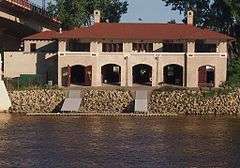 |
(#82004627) |
1 Wabasha Street South 44°56′31″N 93°05′29″W / 44.941944°N 93.091389°W |
Saint Paul | 1910 clubhouse of Minnesota's oldest athletic organization, a rowing club founded in 1870.[71] |
| 64 | Minnesota Building | 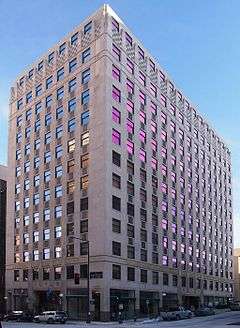 |
(#09000408) |
46 E. 4th St. 44°56′44″N 93°05′31″W / 44.945633°N 93.092003°W |
Saint Paul | 1929 office building that introduced Art Deco and Moderne architecture to downtown Saint Paul, styles which flourished there until 1942.[72] |
| 65 | Minnesota Historical Society Building | |
(#73000994) |
690 Cedar Street 44°57′17″N 93°06′00″W / 44.954722°N 93.1°W |
Saint Paul | Headquarters from 1918 to 1992 of the Minnesota Historical Society, founded in 1849 as the state's oldest institution. Also noted for its architectural contribution to the Capitol complex. Now the Minnesota Judicial Center.[73][74] |
| 66 | Minnesota Milk Company Building |  |
(#13001148) |
370 W. University Ave. 44°57′19″N 93°06′56″W / 44.955416°N 93.115678°W |
Saint Paul | Saint Paul's best surviving example of an urban milk processing facility from the first half of the 20th century, operated by the Minnesota Milk Company 1913–1960.[75] |
| 67 | Minnesota State Capitol |  |
(#72000681) |
Aurora Between Cedar and Park Sts. 44°57′19″N 93°06′06″W / 44.955278°N 93.101667°W |
Saint Paul | Classical Revival capitol designed by Cass Gilbert and built 1896–1905, called "the most perfectly executed monumental public building in the entire state" in its NRHP nomination.[76] |
| 68 | Adolf Muench House | 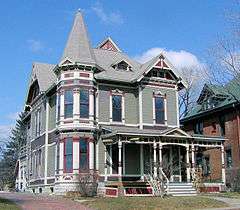 |
(#75001012) |
653 5th Street East 44°57′21″N 93°04′23″W / 44.955833°N 93.073056°W |
Saint Paul | 1884 Queen Anne house of one of the four Muench brothers, 1850s German immigrants who were significant in the early development of Saint Paul and Minnesota.[77] |
| 69 | Northern Pacific Railway Company Como Shops Historic District |  |
(#83000937) |
Energy Park Dr. and Bandana Boulevard 44°58′21″N 93°09′16″W / 44.9725°N 93.154444°W |
Saint Paul | Eight surviving buildings constructed 1885–1920 for the Northern Pacific Railway's passenger car service complex, associated with railroad development and population growth in Saint Paul and the northwestern U.S.[78] Now known as Bandana Square. |
| 70 | Norway Lutheran Church |  |
(#75001013) |
2375 Como Avenue West 44°59′03″N 93°11′42″W / 44.984268°N 93.195023°W |
Saint Paul | First Norwegian Lutheran church in America, built 1843 in the Muskego Settlement, Wisconsin, and moved to Luther Seminary in Saint Paul in 1904. Also noted as an example of pioneer log construction.[79] |
| 71 | Charles P. Noyes Cottage | |
(#76001070) |
4735 Lake Avenue 45°05′07″N 93°00′09″W / 45.085278°N 93.0025°W |
White Bear Lake | Lakeside 1869 Stick style summer cottage, example of the "close-to-nature" retreats built on the urban fringe in the late 19th century.[80] Now the White Bear Lake Area Historical Society's Fillebrown House museum.[81] |
| 72 | O'Donnell Shoe Company Building | 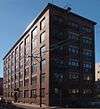 |
(#09000623) |
509 Sibley Street 44°57′09″N 93°05′29″W / 44.9525°N 93.091389°W |
Saint Paul | Factory in operation 1914–1935 of Minnesota's leading shoe manufacturer, a remnant of Saint Paul's once-prominent shoemaking industry.[82] |
| 73 | Old Federal Courts Building | 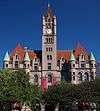 |
(#69000076) |
109 5th Street West 44°56′44″N 93°05′50″W / 44.945556°N 93.097222°W |
Saint Paul | Exemplary Richardsonian Romanesque/Châteauesque federal building built 1894–1901.[83] Now a cultural venue known as Landmark Center. |
| 74 | Old Main, Macalester College | |
(#77000765) |
1600 Grand Avenue 44°56′19″N 93°10′06″W / 44.938611°N 93.168333°W |
Saint Paul | 1888 Richardsonian Romanesque campus building designed by William H. Willcox; the oldest standing structure at Macalester College.[84] The 1884 east wing, part of the original nomination, has been replaced.[85] |
| 75 | Payne Avenue State Bank | 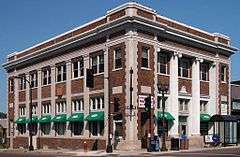 |
(#07000426) |
965 Payne Avenue 44°58′14″N 93°04′26″W / 44.970417°N 93.073889°W |
Saint Paul | 1923 neighborhood bank that provided financial services and commercial space to the largely Swedish American community of Saint Paul's East Side.[86] |
| 76 | Pilgrim Baptist Church | .jpg) |
(#91000438) |
732 Central Avenue West 44°57′10″N 93°07′52″W / 44.952778°N 93.131111°W |
Saint Paul | 1928 church associated with the spiritual, social, and political life of African Americans in the Twin Cities, and with the Reverend L.W. Harris, the congregation's politically active leader from 1922 to 1941.[87] |
| 77 | Pioneer and Endicott Buildings |  |
(#74001038) |
4th and Robert Streets 44°56′49″N 93°05′23″W / 44.947059°N 93.08980°W |
Saint Paul | Architecturally significant office buildings connected in 1941. Cass Gilbert designed the L-shaped Renaissance Revival Endicott Building in the 1890s to wrap around the 1889 Romanesque Revival Pioneer Building designed by Solon Spencer Beman.[88] |
| 78 | Ramsey County Poor Farm Barn | 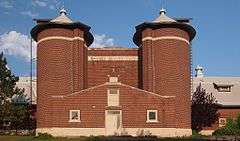 |
(#77000766) |
2020 White Bear Avenue 45°00′01″N 93°01′27″W / 45.000278°N 93.024167°W |
Maplewood | Massive 1918 livestock barn of Ramsey County's poor farm, a substantial remnant of a once-common municipal welfare method.[89] |
| 79 | Alexander Ramsey House |  |
(#69000077) |
265 Exchange Street South 44°56′30″N 93°06′16″W / 44.941667°N 93.104444°W |
Saint Paul | 1868 Second Empire house of statesman Alexander Ramsey, who shaped the early years of Minnesota as governor and senator.[90] Now a Minnesota Historical Society museum.[91] |
| 80 | Justus Ramsey Stone House | 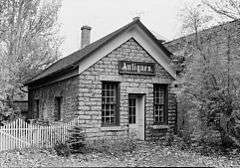 |
(#75001014) |
252 7th Street West 44°56′33″N 93°06′16″W / 44.9425°N 93.104583°W |
Saint Paul | Well-preserved pioneer cottage, built 1855–57, exhibiting fine masonry of local limestone.[92] |
| 81 | Rau/Strong House |  |
(#75001015) |
2 George Street 44°55′46″N 93°05′06″W / 44.92944°N 93.084866°W |
Saint Paul | Finely crafted "urban estate" built 1884–86, with an eclectic Italianate/Second Empire/Eastlake Movement house and accompanying carriage barn, representative of Saint Paul's late-19th-century middle class residences.[93] |
| 82 | Riverside Hangar |  |
(#07001315) |
690 Bayfield Street, Building 690-01-01 44°56′30″N 93°03′43″W / 44.941667°N 93.061944°W |
Saint Paul | 1942 hangar complex uniquely constructed of glued laminated timber arches, a creative response to a World War II steel shortage.[94] |
| 83 | Riverview Branch Library | |
(#84001672) |
1 George Street East 44°55′48″N 93°05′05″W / 44.93°N 93.084722°W |
Saint Paul | One of three Beaux-Arts Carnegie libraries built in Saint Paul 1916–17, significant for their role in education and as city architect Charles A. Hausler's first public buildings. |
| 84 | Robert Street Bridge |  |
(#89001846) |
Robert Street over Mississippi River 44°56′38″N 93°05′15″W / 44.943889°N 93.087389°W |
Saint Paul | Exemplary multi-span reinforced-concrete arch bridge with one monumental through arch span, built 1924–26 and tightly engineered to accommodate adjacent river, road, and rail traffic.[95] |
| 85 | Rochat-Louise-Sauerwein Block | 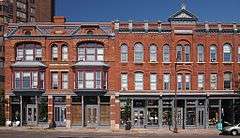 |
(#80002126) |
261–277 7th Street West 44°56′33″N 93°06′20″W / 44.9425°N 93.105556°W |
Saint Paul | Adjacent commercial/residential buildings constructed 1884, 1885, and 1895; examples of fine Victorian architecture and remnants of what once lined West Seventh Street.[96] |
| 86 | St. Agatha's Conservatory of Music and Arts | 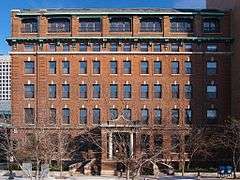 |
(#89000443) |
26 Exchange Street East 44°56′58″N 93°05′48″W / 44.949444°N 93.096667°W |
Saint Paul | Building constructed 1908–1910 for the Twin Cities' oldest school of fine arts, established in 1884. Now known as the Exchange Building.[97] |
| 87 | St. Anthony Park Branch Library |  |
(#84001675) |
2245 Como Avenue West 44°58′52″N 93°11′37″W / 44.980994°N 93.193582°W |
Saint Paul | One of three Beaux-Arts Carnegie libraries built in Saint Paul 1916–17, significant for their role in education and as city architect Charles A. Hausler's first public buildings. |
| 88 | St. Joseph's Academy |  |
(#75001016) |
355 Marshall Avenue 44°56′57″N 93°06′54″W / 44.949167°N 93.115°W |
Saint Paul | Minnesota's oldest standing Catholic school—whose original section dates to 1863—also noted for its early Italianate architecture in yellow limestone.[98] |
| 89 | St. Matthew's School | 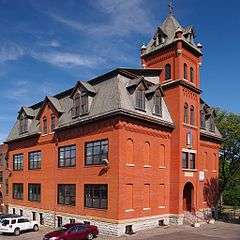 |
(#84000243) |
7 Robie Street West 44°55′51″N 93°05′08″W / 44.930833°N 93.085556°W |
Saint Paul | 1902 school building, one of Saint Paul's oldest, significant for its ornate Second Empire design by John F. Fischer and for providing parochial education to a neighborhood of mostly German Catholic immigrants.[99] |
| 90 | St. Paul Cathedral |  |
(#74001039) |
Summit Avenue at Selby Avenue 44°56′49″N 93°06′32″W / 44.946944°N 93.108889°W |
Saint Paul | Monumental Beaux-Arts cathedral—called "one of the nation's grandest religious edifices" in its NHRP nomination—designed by Emmanuel Louis Masqueray. Principally built 1906–1915 but with interiors not completed by successors until 1953.[100] |
| 91 | St. Paul City Hall and Ramsey County Courthouse | 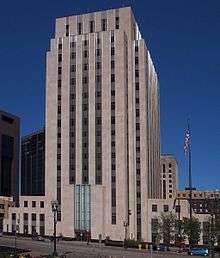 |
(#83000940) |
15 Kellogg Boulevard West 44°56′39″N 93°05′37″W / 44.944167°N 93.093611°W |
Saint Paul | Landmark 1930 Moderne building designed by Holabird & Root and Ellerbe & Co., long-serving government center and one of the nation's few Art Deco skyscrapers with an intact exterior and interior.[101] |
| 92 | St. Paul, Minneapolis, & Manitoba Railway Company Shops Historic District |  |
(#86003564) |
Jackson Street and Pennsylvania Avenue 44°57′45″N 93°05′47″W / 44.9625°N 93.096389°W |
Saint Paul | Surviving three buildings from an 1882 St. Paul, Minneapolis and Manitoba Railway maintenance complex. Notable for their association with James J. Hill and the state's first successful railways, and their early limestone construction.[102] |
| 93 | St. Paul Municipal Grain Terminal | 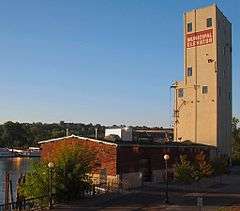 |
(#04000721) |
266 Old Shepard Rd. 44°56′20″N 93°06′00″W / 44.938889°N 93.1°W |
Saint Paul | Nation's first cooperative, farmer-owned terminal elevator, completed 1931, also associated with mechanical advances and the revitalization of grain transport on the Mississippi River.[103] |
| 94 | St. Paul Public Library/James J. Hill Reference Library | |
(#75001017) |
80–90 4th Street West 44°56′38″N 93°05′50″W / 44.943873°N 93.097125°W |
Saint Paul | 1917 Renaissance Revival joint library building, with the James J. Hill Reference Library wing further notable as an example of railroad magnate James J. Hill's philanthropic accomplishments.[104] |
| 95 | St. Paul Union Depot |  |
(#74001040) |
214 4th Street East 44°56′52″N 93°05′10″W / 44.947778°N 93.086111°W |
Saint Paul | Landmark Neoclassical train station built 1917–23 by seven railways, symbol of Saint Paul's importance as a railroad hub and example of the era's monumental public buildings.[105]
Boundary increase on 2014-03-04. |
| 96 | St. Paul Women's City Club | 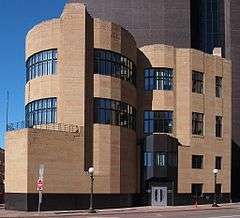 |
(#82004628) |
305 Saint Peter Street 44°56′38″N 93°05′41″W / 44.943911°N 93.094679°W |
Saint Paul | 1931 women's club headquarters notable for its early and exemplary use of Moderne architecture in Saint Paul.[106] |
| 97 | Salvation Army Women's Home and Hospital | 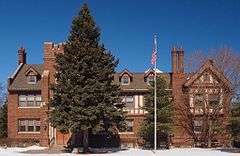 |
(#83000938) |
1471 Como Avenue West 44°58′41″N 93°09′46″W / 44.978056°N 93.162778°W |
Saint Paul | 1912 Tudor Revival facility designed by Clarence H. Johnston, Sr., where The Salvation Army provided charitable services to unwed mothers and their children up to 1971.[107] |
| 98 | Charles W. Schneider House |  |
(#84001677) |
1750 Ames Place East 44°58′16″N 93°01′36″W / 44.971111°N 93.026667°W |
Saint Paul | 1890 Shingle Style house, a style rare in Saint Paul, and the most architecturally significant standing house from the 1887 Hazel Park neighborhood development.[108] |
| 99 | Schornstein Grocery and Saloon |  |
(#84001681) |
707 Wilson Avenue East and 223 Bates Avenue North 44°57′12″N 93°03′59″W / 44.953219°N 93.066289°W |
Saint Paul | Ornate 1884 Victorian commercial building with an eclectic Second Empire/Italianate design by Augustus F. Gauger.[109] |
| 100 | Seventh Street Improvement Arches |  |
(#89001828) |
East 7th Street over Burlington Northern right-of-way 44°57′24″N 93°04′37″W / 44.956667°N 93.076944°W |
Saint Paul | 1884 limestone double-arch bridge significant for its rare and challenging skewed, helicoidal design.[110] |
| 101 | Sam S. Shubert Theatre and Shubert Building |  |
(#10000475) |
488–494 Wabasha Street North 44°56′57″N 93°05′50″W / 44.94905°N 93.097353°W |
Saint Paul | 1910 Beaux-Arts Shubert Brothers theatre—important in Saint Paul's early fine theatre scene—and adjacent commercial building designed by Buechner & Orth. Now known as the Fitzgerald Theatre and Fitzgerald Condominiums.[111] |
| 102 | Frederick Spangenberg House | 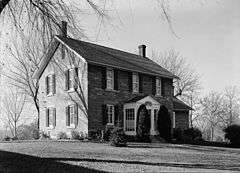 |
(#76001068) |
375 Mt. Curve Boulevard 44°55′49″N 93°11′39″W / 44.930278°N 93.194167°W |
Saint Paul | One of Saint Paul's oldest standing stone farmhouses, built in 1864 of local limestone when the site was still on the rural outskirts of town.[112] |
| 103 | Charles Thompson Memorial Hall |  |
(#11000949) |
1824 Marshall Ave. 44°56′53″N 93°10′39″W / 44.948036°N 93.177528°W |
Saint Paul | 1916 Classical Revival meeting hall designed by deaf architect Olof Hanson as the nation's first clubhouse built for a deaf community. A hub of social and advocacy activity credited with helping foster Minnesota as a preferred location among deaf people.[113] |
| 104 | Triune Masonic Temple | 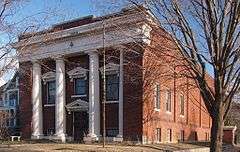 |
(#80002127) |
1898 Iglehart Avenue 44°56′57″N 93°10′50″W / 44.949167°N 93.180556°W |
Saint Paul | One of Minnesota's earliest and best-preserved freestanding Masonic Temples, built 1910–11 in Neoclassical style by Henry C. Struchen.[114] |
| 105 | United Church Seminary | 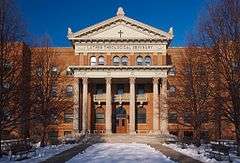 |
(#85003437) |
2481 Como Avenue 44°59′05″N 93°11′47″W / 44.984722°N 93.196389°W |
Saint Paul | 1900 Beaux-Arts campus building designed by Omeyer & Thori; focal point of a longstanding Lutheran seminary. Now known as Luther Seminary's Bockman Hall.[115] |
| 106 | United States Post Office and Custom House | 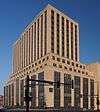 |
(#14000218) |
180 Kellogg Boulevard E. 44°56′47″N 93°05′13″W / 44.946410°N 93.087040°W |
Saint Paul | Center of Saint Paul's postal operations 1934–2010, with major additions in 1939 and 1961; associated with the 20th-century expansion and modernization of the United States Postal Service.[116] |
| 107 | University Hall-Old Main, Hamline University | 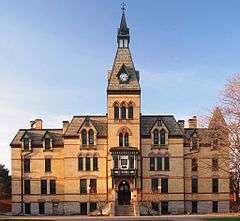 |
(#77000767) |
1536 Hewitt Avenue 44°57′57″N 93°09′56″W / 44.965833°N 93.165556°W |
Saint Paul | 1883 Victorian Gothic campus building designed by Warren H. Hayes; the oldest standing structure at Hamline University.[117] |
| 108 | Vienna and Earl Apartment Buildings | |
(#84001685) |
682–688 Holly Avenue 44°56′35″N 93°07′45″W / 44.943056°N 93.129167°W |
Saint Paul | 1907 Neoclassical luxury apartment buildings, the crowning work of architect Louis F. Lockwood and builder Carl P. Waldon.[118] |
| 109 | Walsh Building | 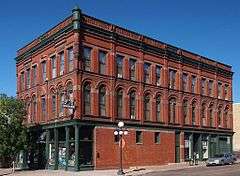 |
(#89000444) |
189–191 7th Street East 44°57′03″N 93°05′27″W / 44.950833°N 93.090833°W |
Saint Paul | Built in 1888, a highly ornamented example of a mixed commercial/residential building and the work of architect Edward Bassford.[119] |
| 110 | West Summit Avenue Historic District | 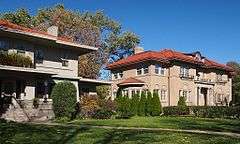 |
(#93000332) |
Summit Avenue between Lexington Parkway and Mississippi River Boulevard 44°56′29″N 93°10′37″W / 44.941389°N 93.176944°W |
Saint Paul | 42-block boulevard notable for its urban planning and assorted Period Revival architecture. A western continuation of the Historic Hill District, with 232 contributing properties built between 1885 and 1938.[120] |
| 111 | Woodland Park District | 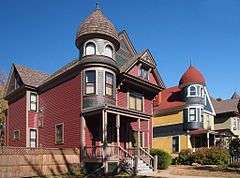 |
(#78001559) |
Roughly bounded by Marshall and Selby Avenues, Arundel and Dale Streets 44°56′52″N 93°07′21″W / 44.947778°N 93.1225°W |
Saint Paul | Middle-class residential neighborhood exhibiting 12 distinct architectural styles popular in Minnesota between 1880 and 1910.[121] Consists of 62 single- and multi-family residences and one church.[122] |
| 112 | Anthony Yoerg, Sr. House |  |
(#89000442) |
215 Isabel Street West 44°56′00″N 93°05′41″W / 44.933333°N 93.094722°W |
Saint Paul | 1875 frame Second Empire house of a prominent Bavarian immigrant who established Minnesota's first brewery. Also notable as a rare surviving work of early Saint Paul architect Monroe Sheire.[123] |
Former listings
| [2] | Name on the Register | Image | Date listed | Date removed | Location | City or town | Summary |
|---|---|---|---|---|---|---|---|
| 1 | William Dahl House | 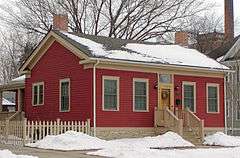 |
(#78001557) | 508 Jefferson Avenue 44°56′03″N 93°07′17″W / 44.9341°N 93.12125°W |
Saint Paul | Built by William Dahl and his Irish wife Catherine Margaret Murphy in 1858, the home was moved from 136 13th Street in 1997. | |
| 2 | S. Edward Hall House | |
(#91000440) | 996 Iglehart Avenue 44°56′58″N 93°08′32″W / 44.949306°N 93.142361°W |
Saint Paul | House of S. Edward Hall (1878–1975), a longtime civic leader in Saint Paul's African American community.[124] Demolished in 2011.[125] | |
| 3 | Selby Avenue Bridge |  |
(#89001833) | Selby Avenue over Soo Line Railroad Tracks |
Saint Paul | 1890 Pratt through truss bridge.[126] | |
| 4 | Smith Avenue High Bridge |  |
(#81000323) | Smith Avenue over the Mississippi River |
Saint Paul | 2,770-foot (840 m) iron Warren truss bridge built in 1889. Replaced in 1985 due to irreparable deficiencies.[127] | |
| 5 | Wabasha Street Bridge | .jpg) |
(#89001834) | Wabasha Street of Mississippi River |
Saint Paul | Cantilever deck truss bridge built in two phases 1890 and 1900. Dismantled in 1996 to make way for a sturdier replacement.[127] |
Unlisted nominations
| [128] | Site name | Image | Date nominated | Location | City or town | Summary |
|---|---|---|---|---|---|---|
| 1 | Joseph Brings House | 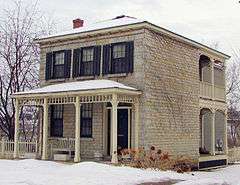 |
(#83004868) |
178 Goodrich Avenue 44°56′16″N 93°06′28″W / 44.937639°N 93.107639°W |
Saint Paul | Also known as the Johan and Maria Magdalena Schilliger House; originally located at 314 Smith Avenue North, the home was built between 1859 and 1862 by John Schilliger,[129] and purchased by Brings in 1863; a cooper, Joseph Brings (1820–1899) was born in Germany and came to Saint Paul in 1857. |
| 2 | Edward and Elizabeth Heimbach House and Carriage House | |
(#83004628) |
64 Delos Street West 44°56′02″N 93°05′16″W / 44.933889°N 93.087778°W |
Saint Paul | 1890 high Victorian style two story, 2,556-square-foot (237.5 m2) brick house; the house has an octagonal tower and dome and a detached carriage house. |
| 3 | James J. Hill's North Oaks Farm, Blacksmith Shop and Machine Shop |  |
(#98000312) |
Red Barn Road and Hill Farm Circle 45°05′33″N 93°06′30″W / 45.0925°N 93.108333°W |
North Oaks | Remnants of James J. Hill's experimental crop and livestock farm, established 1884–90 to promote diversified farming along his Great Northern Railway.[48] Now a non-profit historic attraction.[49] |
| 4 | Otto W. Rohland Building | 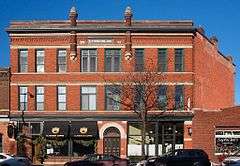 |
(#83004865) |
455–459 Old Fort Road (West 7th Street) 44°56′17″N 93°06′41″W / 44.938056°N 93.111389°W |
Saint Paul | Rohland immigrated from Germany in 1867; this Victorian shop/residential building was built in 1891 and served as Rohland's grocery store and meat market into the 1950s. |
| 5 | St. Paul Seminary Historic District |  |
(#86003818) |
2260 Summit Avenue 44°56′26″N 93°11′44″W / 44.940556°N 93.195556°W |
Saint Paul | Now part of the University of Saint Thomas, the first six buildings were built and endowed by the Methodist millionaire James J. Hill, who gave the school to the Archdiocese of Saint Paul and Minneapolis to honor his Catholic wife Mary Mehegan Hill. |
| 6 | Salvation Army Headquarters | 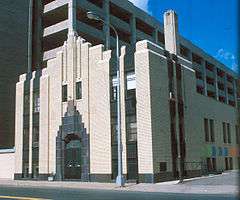 |
(#83004629) |
57 10th Street West 44°56′03″N 93°07′17″W / 44.9341°N 93.12125°W |
Saint Paul | Not listed: Owner Objection. Demolished. |
| 7 | Anthony Waldman House | 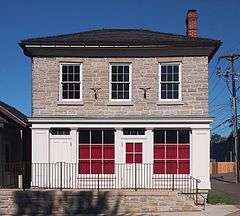 |
(#83004866) |
445 Smith Avenue North 44°56′18″N 93°06′34″W / 44.938333°N 93.109444°W |
Saint Paul | 1864 home of Anthony Waldman a Czech immigrant and his German-born wife[129] |
| 8 | Martin Weber House | 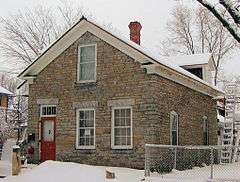 |
(#83004867) |
202 McBoal Street 44°56′20″N 93°06′31″W / 44.938889°N 93.108611°W |
Saint Paul | 1867 home of Catherin and Martin Weber; built by German immigrant stonemasons Jacob Amos and Christian Rhinehardt.[129] |
See also
- List of National Historic Landmarks in Minnesota
- National Register of Historic Places listings in Minnesota
References
- ↑ "National Register of Historic Places: Weekly List Actions". National Park Service, United States Department of the Interior. Retrieved on December 16, 2016.
- 1 2 Numbers represent an ordering by significant words. Various colorings, defined here, differentiate National Historic Landmarks and historic districts from other NRHP buildings, structures, sites or objects.
- ↑ National Park Service (2008-04-24). "National Register Information System". National Register of Historic Places. National Park Service.
- ↑ The eight-digit number below each date is the number assigned to each location in the National Register Information System database, which can be viewed by clicking the number.
- ↑ Schmidt, Andrew J.; Marjorie Pearson; Renee L. Hutter; Emily Ramsey (2014-05-21). "National Register of Historic Places Registration Form: 3M Administration Building" (PDF). National Park Service. Retrieved 2015-05-04.
- ↑ Murphy, Patricia; Julia Pavlon (1981-10-08). "National Register of Historic Places Registration Form: Armstrong House" (PDF). National Park Service. Retrieved 2013-04-28.
- ↑ Nelson, Charles W. (1974-10-24). "National Register of Historic Places Registration Form: Assumption School" (PDF). National Park Service. Retrieved 2013-04-28.
- ↑ Kunz, Virginia B. (1977-01-12). "National Register of Historic Places Registration Form: Beebe, Dr. Ward, House" (PDF). National Park Service. Retrieved 2013-04-28.
- 1 2 "West Summit Avenue Historic District". Minnesota Historical Society. 2009. Retrieved 2013-04-28.
- ↑ Nelson, Charles W. (1975-04-28). "National Register of Historic Places Registration Form: Blair Flats, (Albion Hotel)" (PDF). National Park Service. Retrieved 2013-04-28.
- 1 2 3 4 5 6 "Historic Hill District". Minnesota Historical Society. 2009. Retrieved 2013-04-28.
- ↑ Frame III, Robert M. (1988-08-15). "National Register of Historic Places Registration Form: Bridges No. L.-5853 and 92247" (PDF). National Park Service. Retrieved 2013-04-28.
- ↑ Zahn, Thomas R.; Steve Mueller (1999-08-26). "National Register of Historic Places Registration Form: Brooks, Edward, Sr. and Markell, House" (PDF). National Park Service. Retrieved 2013-04-28.
- ↑ Lutz, Thomas (1974-12-26). "National Register of Historic Places Registration Form: Benjamin Brunson House" (PDF). National Park Service. Retrieved 2013-04-28.
- ↑ Granger, Susan; Kay Grossman (1996-02-15). "National Register of Historic Places Registration Form: Bullard, Casiville House" (PDF). National Park Service. Retrieved 2013-04-29.
- ↑ Grossman, John (1970-04-10). "National Register of Historic Places Registration Form: Burbank - Livingston - Griggs House" (PDF). National Park Service. Retrieved 2013-04-29.
- ↑ Nelson, Charles; Susan Roth (March 1981). "National Register of Historic Places Registration Form: Butler, Pierce and Walter, House" (PDF). National Park Service. Retrieved 2013-04-29.
- ↑ Heise, Marlin L. (1976-07-16). "National Register of Historic Places Registration Form: C.S.P.S. Hall" (PDF). National Park Service. Retrieved 2013-04-29.
- ↑ Granger, Susan (1981-10-01). "National Register of Historic Places Registration Form: Central Presbyterian Church" (PDF). National Park Service. Retrieved 2013-05-03.
- ↑ Schuler, Richard J.; Charles W. Nelson (1980-05-29). "National Register of Historic Places Registration Form: Church of St. Agnes" (PDF). National Park Service. Retrieved 2013-05-03.
- ↑ Murphy, Patricia (1981-10-14). "National Register of Historic Places Registration Form: Church of St. Bernard" (PDF). National Park Service. Retrieved 2013-05-03.
- ↑ Whitney, Gayle; Susan Granger (1981-10-30). "National Register of Historic Places Registration Form: Church of St. Casimir" (PDF). National Park Service. Retrieved 2013-05-03.
- ↑ Nelson, Charles W. (1974-10-24). "National Register of Historic Places Registration Form: Assumption Church" (PDF). National Park Service. Retrieved 2013-05-03.
- ↑ Murphy, Patricia (1981-11-20). "National Register of Historic Places Registration Form: Cobb, Cyrus B., House" (PDF). National Park Service. Retrieved 2013-05-03.
- ↑ Hess, Jeffrey A. (August 1988). "National Register of Historic Places Registration Form: Colorado Street Bridge" (PDF). National Park Service. Retrieved 2013-05-03.
- ↑ Zellie, Carole S.; Amy M. Lucas (2007-03-06). "National Register of Historic Places Registration Form: Commerce Building" (PDF). National Park Service. Retrieved 2013-05-03.
- ↑ Nelson, Charles W. (1974-08-20). "National Register of Historic Places Registration Form: Como Conservatory" (PDF). National Park Service. Retrieved 2013-05-03.
- ↑ Murphy, Patricia (December 1982). "National Register of Historic Places Registration Form: Davern, William and Catherine, Farmhouse" (PDF). National Park Service. Retrieved 2013-05-03.
- ↑ Murphy, Patricia (May 1984). "National Register of Historic Places Registration Form: College of St. Catherine: Derham Hall and Our Lady of Victory Chapel" (PDF). National Park Service. Retrieved 2013-05-03.
- ↑ Roise, Charlene K.; Stephanie K. Atwood (August 2013). "National Register of Historic Places Registration Form: Euclid View Flats" (PDF). National Park Service. Retrieved 2015-05-05.
- ↑ Nelson, Charles W. (January 1981). "National Register of Historic Places Registration Form: Finch, VanSlyck and McConville Dry Goods Company Building" (PDF). National Park Service. Retrieved 2013-05-03.
- ↑ "Historic Hill District". Minnesota Historical Society. 2009. Retrieved 2013-05-03.
- ↑ Granger, Susan (1981-10-31). "National Register of Historic Places Registration Form: First Baptist Church of St. Paul" (PDF). National Park Service. Retrieved 2013-05-03.
- ↑ Murphy, Patricia (June 1982). "National Register of Historic Places Inventory—Nomination Form: First National Bank of White Bear" (PDF). National Park Service. Retrieved 2015-05-07.
- ↑ Gable, Robert; Edmund Preston. "National Register of Historic Places Registration Form: Summit Terrace" (PDF). National Park Service. Retrieved 2013-05-03.
- ↑ Zimniewicz, Jeanne M. (1990-03-05). "National Register of Historic Places Registration Form: Fitzpatrick Building" (PDF). National Park Service. Retrieved 2013-05-03.
- ↑ Granger, Susan (1982-06-21). "National Register of Historic Places Registration Form: Foss House" (PDF). National Park Service. Retrieved 2013-05-03.
- ↑ Nelson, Charles W.; Susan Zeig (1977-04-01). "National Register of Historic Places Registration Form: Germania Bank Building" (PDF). National Park Service. Retrieved 2013-05-03.
- ↑ Nystuen, David W.; Thomas Lutz (1974-10-30). "National Register of Historic Places Registration Form: Gibbs Farm" (PDF). National Park Service. Retrieved 2013-05-03.
- ↑ Sazevich, James A. (1981-05-07). "National Register of Historic Places Registration Form: Giesen-Hauser House" (PDF). National Park Service. Retrieved 2013-05-04.
- ↑ Hoisington, Daniel J. "National Register of Historic Places Registration Form: Hamline Methodist Episcopal Church" (PDF). National Park Service. Retrieved 2013-05-04.
- ↑ Bourgerie, Gabrielle (1997-01-06). "National Register of Historic Places Registration Form: Hamm Building" (PDF). National Park Service. Retrieved 2013-05-03.
- ↑ Sluss, Jacqueline (1990-07-16). "National Register of Historic Places Registration Form: Harriet Island Pavilion" (PDF). National Park Service. Retrieved 2013-05-03.
- ↑ Millett, Larry (2007). AIA Guide to the Twin Cities: The Essential Source on the Architecture of Minneapolis and St. Paul. Minnesota Historical Society Press. p. 404. ISBN 0-87351-540-4.
- ↑ Murphy, Patricia (June 1984). "National Register of Historic Places Registration Form: Highland Park Tower" (PDF). National Park Service. Retrieved 2013-05-01.
- ↑ Lissandrello, Stephen; Cecil McKithan. "National Register of Historic Places Registration Form: James J. Hill Home" (PDF). National Park Service. Retrieved 2013-05-01.
- ↑ Peterson, Garneth O. (1997-02-10). "National Register of Historic Places Registration Form: Dairy Building, North Oaks Farm" (PDF). National Park Service. Retrieved 2013-05-01.
- 1 2 "Dairy Building, Granary/Root Cellar and Auxiliary Buildings, North Oaks Farm (boundary increase)". Minnesota National Register Properties Database. Minnesota Historical Society. 2009. Retrieved 2013-05-01.
- 1 2 "Hill Farm Historical Society". Retrieved 2013-05-01.
- ↑ Sazevich, James A. (1977-01-10). "National Register of Historic Places Registration Form: Hinkel-Sullivan House" (PDF). National Park Service. Retrieved 2013-04-30.
- ↑ Nelson, Charles W.; Susan Zeik (1976-06-07). "National Register of Historic Places Registration Form: Historic Hill District" (PDF). National Park Service. Retrieved 2013-04-30.
- ↑ Carstens, Greg; Susan Granger (1982-06-18). "National Register of Historic Places Registration Form: E. H. Hobe House/Solheim" (PDF). National Park Service. Retrieved 2013-04-30.
- ↑ Sluss, Jacqueline; Rolf Anderson (1990-07-16). "National Register of Historic Places Registration Form: Holman Field Administration Building" (PDF). National Park Service. Retrieved 2013-04-30.
- ↑ Arnot, Sigrid; Geoff Jones; David Maki (2013-04-20). "National Register of Historic Places Registration Form: Indian Mounds Park Mound Group" (PDF). National Park Service. Retrieved 2015-05-18.
- ↑ Frame III, Robert M. (1988-08-15). "National Register of Historic Places Registration Form: Intercity Bridge" (PDF). National Park Service. Retrieved 2013-04-30.
- ↑ VanBrocklin, Lynne (1974-09-12). "National Register of Historic Places Registration Form: Minnesota State Ceremonial Building" (PDF). National Park Service. Retrieved 2013-04-30.
- ↑ Lutz, Thomas (1973-10-03). "National Register of Historic Places Registration Form: Irvine Park Historic District" (PDF). National Park Service. Retrieved 2013-04-30.
- ↑ "Irvine Park Historic District". Minnesota National Register Properties Database. Minnesota Historical Society. 2009. Retrieved 2013-04-30.
- ↑ Alexander, Cathy A.; Ralph Christian; George R. Adams (January 1976). "National Register of Historic Places Registration Form: Frank Billings Kellogg House" (PDF). National Park Service. Retrieved 2013-04-29.
- ↑ Murphy, Patricia; Greg Carstens (June 1982). "National Register of Historic Places Registration Form: Krank Manufacturing Company" (PDF). National Park Service. Retrieved 2013-04-29.
- ↑ Nelson, Charles W. (1975-02-24). "National Register of Historic Places Registration Form: Lauer Flats" (PDF). National Park Service. Retrieved 2013-04-29.
- ↑ Murphy, Patricia (June 1983). "National Register of Historic Places Registration Form: Lee, Olaf, House" (PDF). National Park Service. Retrieved 2013-04-29.
- ↑ Anfinson, John; Jack Maloney (2003-01-06). "National Register of Historic Places Registration Form: Lock and Dam No. 2" (PDF). National Park Service. Retrieved 2013-04-29.
- ↑ Murphy, Patricia; Susan Granger (1981-11-30). "National Register of Historic Places Registration Form: Lowertown Historic District" (PDF). National Park Service. Retrieved 2013-04-27.
- ↑ Lutz, Thomas (1974-12-23). "National Register of Historic Places Registration Form: Luckert, David, House" (PDF). National Park Service. Retrieved 2013-04-27.
- ↑ Roberts, Norene A. (1987-12-30). "National Register of Historic Places Registration Form: Manhattan Building" (PDF). National Park Service. Retrieved 2013-04-27.
- ↑ VanBrocklin, Lynne (1974-10-15). "National Register of Historic Places Registration Form: McGill, Andrew R., House" (PDF). National Park Service. Retrieved 2013-04-27.
- ↑ Hess, Jeffrey A. (August 1988). "National Register of Historic Places Registration Form: Mendota Road Bridge" (PDF). National Park Service. Retrieved 2013-04-27.
- ↑ VanBrocklin, Lynne; Thomas J. Lutz (1974-10-15). "National Register of Historic Places Registration Form: Merchants National Bank Building" (PDF). National Park Service. Retrieved 2013-04-27.
- ↑ Murphy, Patricia; Marie Mingo (August 1981). "National Register of Historic Places Registration Form: Mickey's Diner" (PDF). National Park Service. Retrieved 2013-04-27.
- ↑ Holmberg, Douglas L. (March 1981). "National Register of Historic Places Registration Form: Minnesota Boat Club Boathouse on Raspberry Island" (PDF). National Park Service. Retrieved 2013-04-27.
- ↑ Gladhill, Bethany; Thomas R. Zahn (2008-12-31). "National Register of Historic Places Registration Form: Minnesota Building". National Park Service.
- ↑ Coddington, Don (1972-06-28). "National Register of Historic Places Registration Form: Minnesota Historical Society" (PDF). National Park Service. Retrieved 2013-04-27.
- ↑ "History of the Minnesota Historical Society". Retrieved 2008-03-24.
- ↑ Zahn, Thomas R. (2013-07-22). "National Register of Historic Places Registration Form: Minnesota Milk Company Building" (PDF). National Park Service. Retrieved 2014-05-23.
- ↑ Cavin, Brooks (1971-10-27). "National Register of Historic Places Registration Form: Minnesota State Capitol" (PDF). National Park Service. Retrieved 2013-04-27.
- ↑ Lutz, Thomas (1974-12-27). "National Register of Historic Places Registration Form: Muench, Adolf, House" (PDF). National Park Service. Retrieved 2013-04-27.
- ↑ Murphy, Patricia (June 1982). "National Register of Historic Places Registration Form: Northern Pacific Railway Company's Como Shops Historic District" (PDF). National Park Service. Retrieved 2013-04-16.
- ↑ Hackett, John J. (1974-11-20). "National Register of Historic Places Registration Form: Muskego Church" (PDF). National Park Service. Retrieved 2013-04-16.
- ↑ Nelson, Charles W. (1976-07-20). "National Register of Historic Places Registration Form: C.P. Noyes Cottage" (PDF). National Park Service. Retrieved 2013-04-16.
- ↑ "Museums". White Bear Lake Area Historical Society. Retrieved 2013-04-16.
- ↑ Lucas, Amy M. (2009-03-02). "National Register of Historic Places Registration Form: O'Donnell Shoe Company Building" (PDF). National Park Service. Retrieved 2013-04-16.
- ↑ Ferguson, John R. (1969-02-26). "National Register of Historic Places Registration Form: Old Federal Courts Building, St. Paul, Minnesota" (PDF). National Park Service. Retrieved 2013-04-16.
- ↑ Spaeth, Lynne VanBrocklin (1977-01-14). "National Register of Historic Places Registration Form: Old Main -- Macalester College" (PDF). National Park Service. Retrieved 2013-04-16.
- ↑ Macalester College (2010-12-03). "Original Building and Old Main". Flickr. Retrieved 2013-04-16.
- ↑ Zellie, Carole S. (2006-12-08). "National Register of Historic Places Registration Form: Payne Avenue State Bank" (PDF). National Park Service. Retrieved 2013-04-15.
- ↑ Sluss, Jacqueline (1990-07-16). "National Register of Historic Places Registration Form: Pilgrim Baptist Church" (PDF). National Park Service. Retrieved 2013-04-15.
- ↑ Lutz, Thomas (1974-05-29). "National Register of Historic Places Registration Form: Pioneer and Endicott Buildings" (PDF). National Park Service. Retrieved 2013-04-14.
- ↑ Kunz, Virginia B.; Robert Drake (October 1976). "National Register of Historic Places Registration Form: Ramsey County Poor Farm Barn" (PDF). National Park Service. Retrieved 2013-04-14.
- ↑ Grossman, John (1969-10-02). "National Register of Historic Places Registration Form: Ramsey (Alexander) House" (PDF). National Park Service. Retrieved 2013-04-14.
- ↑ "Alexander Ramsey House". Minnesota Historical Society. Retrieved 2013-04-14.
- ↑ Lutz, Thomas (1975-03-26). "National Register of Historic Places Registration Form: Justus Ramsey Stone House" (PDF). National Park Service. Retrieved 2013-04-13.
- ↑ Nelson, Charles W. (1974-11-08). "National Register of Historic Places Registration Form: Strong, Ossian R., House" (PDF). National Park Service. Retrieved 2013-04-13.
- ↑ Gales, Elizabeth A. (2007-07-19). "National Register of Historic Places Registration Form: Riverside Hangar" (PDF). National Park Service. Retrieved 2013-04-13.
- ↑ Frame III, Robert M. (1988-08-15). "National Register of Historic Places Registration Form: Robert Street Bridge" (PDF). National Park Service. Retrieved 2013-04-13.
- ↑ Pfoutz, Terry; Charles W. Nelson (1980-05-02). "National Register of Historic Places Registration Form: Rochat-Louise-Sauerwein Block" (PDF). National Park Service. Retrieved 2013-04-12.
- ↑ Zahn, Thomas R. (1988-12-22). "National Register of Historic Places Registration Form: St. Agatha's Conservatory of Music and Arts" (PDF). National Park Service. Retrieved 2013-04-11.
- ↑ Lutz, Thomas J. (1974-12-19). "National Register of Historic Places Registration Form: St. Joseph's School" (PDF). National Park Service. Retrieved 2013-04-10.
- ↑ Granger, Susan (March 1984). "National Register of Historic Places Registration Form: St. Matthew's School" (PDF). National Park Service. Retrieved 2013-04-07.
- ↑ Lutz, Thomas (1974-03-29). "National Register of Historic Places Registration Form: St. Paul Cathedral" (PDF). National Park Service. Retrieved 2013-04-07.
- ↑ Murphy, Patricia (1981-10-01). "National Register of Historic Places Registration Form: St. Paul City Hall and Ramsey County Courthouse" (PDF). National Park Service. Retrieved 2013-04-07.
- ↑ Mecum, John D. (1986-06-01). "National Register of Historic Places Registration Form: St. Paul Minneapolis and Manitoba Railway Company Shops Historic District" (PDF). National Park Service. Retrieved 2013-04-07.
- ↑ Anfinson, John O. (2004-02-10). "National Register of Historic Places Registration Form: St. Paul Municipal Grain Elevator" (PDF). National Park Service. Retrieved 2013-04-07.
- ↑ Gilmore, Andrea M. (1975-06-25). "National Register of Historic Places Registration Form: St. Paul Public Library/James J. Hill Reference Library" (PDF). National Park Service. Retrieved 2013-04-06.
- ↑ Lutz, Thomas; Lynne VanBrocklin (1974-11-07). "National Register of Historic Places Registration Form: St. Paul Union Depot" (PDF). National Park Service. Retrieved 2013-04-06.
- ↑ Pfoutz, Terry; Charles W. Nelson (1980-05-02). "National Register of Historic Places Registration Form: St. Paul Women's City Club" (PDF). National Park Service. Retrieved 2013-04-06.
- ↑ Murphy, Patricia; John Fried (November 1981). "National Register of Historic Places Registration Form: Salvation Army Women's Home and Hospital" (PDF). National Park Service. Retrieved 2013-04-06.
- ↑ Murphy, Patricia (May 1983). "National Register of Historic Places Registration Form: Schneider, Charles W., House" (PDF). National Park Service. Retrieved 2013-04-06.
- ↑ Granger, Emily (1982-12-15). "National Register of Historic Places Registration Form: Schornstein Grocery and Saloon" (PDF). National Park Service. Retrieved 2013-04-06.
- ↑ Hess, Jeffrey A. (August 1988). "National Register of Historic Places Registration Form: Seventh Street Improvement Arches" (PDF). National Park Service. Retrieved 2013-04-06.
- ↑ Atwood, Stephanie K.; Penny Petersen; Charlene K. Roise (2010-03-19). "National Register of Historic Places Registration Form: Shubert, Sam S., Theatre and Shubert Building" (PDF). National Park Service. Retrieved 2013-04-06.
- ↑ Nelson, Charles W. (1975-12-24). "National Register of Historic Places Registration Form: Spangenberg, Frederick, House" (PDF). National Park Service. Retrieved 2013-04-06.
- ↑ Stark, William E. (2011-05-30). "National Register of Historic Places Registration Form: Charles Thompson Memorial Hall" (PDF). National Park Service. Retrieved 2012-11-23.
- ↑ Kiima, Harlan D. (1980-03-07). "National Register of Historic Places Registration Form: Triune Masonic Temple" (PDF). National Park Service. Retrieved 2013-04-06.
- ↑ Murphy, Patricia (July 1984). "National Register of Historic Places Registration Form: United Church Seminary" (PDF). National Park Service. Retrieved 2013-04-05.
- ↑ Ramsey, Emily (2013-10-17). "National Register of Historic Places Registration Form: United States Post Office and Custom House" (PDF). National Park Service. Retrieved 2014-08-14.
- ↑ Spaeth, Lynne VanBrocklin (1977-01-14). "National Register of Historic Places Registration Form: University Hall - Hamline University" (PDF). National Park Service. Retrieved 2013-04-05.
- ↑ Sudheimer, Louis C. (1983-06-22). "National Register of Historic Places Registration Form: Vienna and Earl Apartment Buildings" (PDF). National Park Service. Retrieved 2013-04-05.
- ↑ Larson, Paul Clifford (1988-11-21). "National Register of Historic Places Registration Form: Walsh Building" (PDF). National Park Service. Retrieved 2013-04-04.
- ↑ Roberts, Norene A. (1988-07-15). "National Register of Historic Places Registration Form: West Summit Avenue Historic District" (PDF). National Park Service. Retrieved 2013-04-03.
- ↑ Nelson, Charles W. (1977-03-31). "National Register of Historic Places Registration Form: Woodland Park District" (PDF). National Park Service. Retrieved 2013-04-03.
- ↑ "Woodland Park Historic District". Minnesota Historical Society. 2009. Retrieved 2013-04-03.
- ↑ Larson, Paul Clifford (1988-11-21). "National Register of Historic Places Registration Form: Yoerg, Anthony, Sr., House" (PDF). National Park Service. Retrieved 2013-04-03.
- ↑ Sluss, Jacqueline (1990-07-16). "National Register of Historic Places Registration Form: Hall, S. Edward, House" (PDF). National Park Service. Retrieved 2013-05-04.
- ↑ "Hall, S. Edward, House (Razed)". Minnesota's National Register Properties. Minnesota Historical Society. 2009. Retrieved 2013-05-04.
- ↑ "Selby Avenue Bridge (removed)". Minnesota National Register Properties Database. Minnesota Historical Society. 2009. Retrieved 2013-07-25.
- 1 2 El-Hai, Jack (2000). Lost Minnesota: Stories of Vanished Places. Minneapolis: University of Minnesota Press. ISBN 0816635153.
- ↑ Numbers represent an ordering by significant words. Various colorings, defined here, differentiate National Historic Landmark sites and National Register of Historic Places Districts from other NRHP buildings, structures, sites or objects.
- 1 2 3 Hess, Jeffrey A.; Paul Clifford Larson. St. Paul's Architecture: A History. University of Minnesota Press.
External links
| Wikimedia Commons has media related to National Register of Historic Places in Ramsey County, Minnesota. |
- Minnesota National Register Properties Database—Minnesota Historical Society

